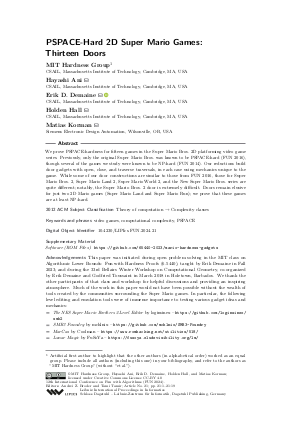PSPACE-Hard 2D Super Mario Games: Thirteen Doors
Authors
MIT Hardness Group,
Hayashi Ani,
Erik D. Demaine  ,
Holden Hall,
Matias Korman
,
Holden Hall,
Matias Korman
-
Part of:
Volume:
12th International Conference on Fun with Algorithms (FUN 2024)
Part of: Series: Leibniz International Proceedings in Informatics (LIPIcs)
Part of: Conference: International Conference on Fun with Algorithms (FUN) - License:
 Creative Commons Attribution 4.0 International license
Creative Commons Attribution 4.0 International license
- Publication Date: 2024-05-29
File

PDF
LIPIcs.FUN.2024.21.pdf
- Filesize: 2.39 MB
- 19 pages
Document Identifiers
Subject Classification
ACM Subject Classification
- Theory of computation → Complexity classes
Keywords
- video games
- computational complexity
- PSPACE
Metrics
- Access Statistics
-
Total Accesses (updated on a weekly basis)
0PDF Downloads0Metadata Views
Abstract
We prove PSPACE-hardness for fifteen games in the Super Mario Bros. 2D platforming video game series. Previously, only the original Super Mario Bros. was known to be PSPACE-hard (FUN 2016), though several of the games we study were known to be NP-hard (FUN 2014). Our reductions build door gadgets with open, close, and traverse traversals, in each case using mechanics unique to the game. While some of our door constructions are similar to those from FUN 2016, those for Super Mario Bros. 2, Super Mario Land 2, Super Mario World 2, and the New Super Mario Bros. series are quite different; notably, the Super Mario Bros. 2 door is extremely difficult. Doors remain elusive for just two 2D Mario games (Super Mario Land and Super Mario Run); we prove that these games are at least NP-hard.
Cite As Get BibTex
MIT Hardness Group, Hayashi Ani, Erik D. Demaine, Holden Hall, and Matias Korman. PSPACE-Hard 2D Super Mario Games: Thirteen Doors. In 12th International Conference on Fun with Algorithms (FUN 2024). Leibniz International Proceedings in Informatics (LIPIcs), Volume 291, pp. 21:1-21:19, Schloss Dagstuhl – Leibniz-Zentrum für Informatik (2024)
https://doi.org/10.4230/LIPIcs.FUN.2024.21
BibTex
@InProceedings{mithardnessgroup_et_al:LIPIcs.FUN.2024.21,
author = {MIT Hardness Group and Ani, Hayashi and Demaine, Erik D. and Hall, Holden and Korman, Matias},
title = {{PSPACE-Hard 2D Super Mario Games: Thirteen Doors}},
booktitle = {12th International Conference on Fun with Algorithms (FUN 2024)},
pages = {21:1--21:19},
series = {Leibniz International Proceedings in Informatics (LIPIcs)},
ISBN = {978-3-95977-314-0},
ISSN = {1868-8969},
year = {2024},
volume = {291},
editor = {Broder, Andrei Z. and Tamir, Tami},
publisher = {Schloss Dagstuhl -- Leibniz-Zentrum f{\"u}r Informatik},
address = {Dagstuhl, Germany},
URL = {https://drops.dagstuhl.de/entities/document/10.4230/LIPIcs.FUN.2024.21},
URN = {urn:nbn:de:0030-drops-199295},
doi = {10.4230/LIPIcs.FUN.2024.21},
annote = {Keywords: video games, computational complexity, PSPACE}
}
Author Details
Acknowledgements
This paper was initiated during open problem solving in the MIT class on Algorithmic Lower Bounds: Fun with Hardness Proofs (6.5440), taught by Erik Demaine in Fall 2023; and during the 33rd Bellairs Winter Workshop on Computational Geometry, co-organized by Erik Demaine and Godfried Toussaint in March 2018 in Holetown, Barbados. We thank the other participants of that class and workshop for helpful discussions and providing an inspiring atmosphere. Much of the work in this paper would not have been possible without the wealth of tools created by the communities surrounding the Super Mario games. In particular, the following level editing and emulation tools were of immense importance to testing various gadget ideas and mechanics:
- The NES Super Mario Brothers 2 Level Editor by loginsinex - https://github.com/loginsinex/smb2
- SMB3 Foundry by mchlnix - https://github.com/mchlnix/SMB3-Foundry
- MarCas by Coolman - https://www.romhacking.net/utilities/518/
- Lunar Magic by FuSoYa - https://fusoya.eludevisibility.org/lm/
- Golden Egg by Romi - https://www.smwcentral.net/?p=section&a=details&id=4645
- Reggie! by the NSMBW Community - https://github.com/NSMBW-Community/Reggie-Updated
- CoinKiller by Arisotura - https://github.com/Arisotura/CoinKiller
- Miyamoto by aboood40091 - https://github.com/aboood40091/Miyamoto
- BizHawk by TASEmulators - https://github.com/TASEmulators/BizHawk
- Mesenrta by threecreepio - https://github.com/threecreepio/mesenrta
- Mesenrta-s by threecreepio - https://github.com/threecreepio/mesenrta-s
- mGBA by endrift - https://mgba.io/
- Dolphin by the Dolphin Emulator Project - https://dolphin-emu.org/
- Citra by Citra Team - https://citra-emu.org/
- Cemu by Team Cemu - https://cemu.info/
Supplementary Materials
- Software (ROM Files) https://github.com/65440-2023/mario-hardness-gadgets
References
- Greg Aloupis, Erik D. Demaine, Alan Guo, and Giovanni Viglietta. Classic Nintendo games are (computationally) hard. Theoretical Computer Science, 586:135-160, 2015. URL: https://doi.org/10.1016/j.tcs.2015.02.037.
- Hayashi Ani, Jeffrey Bosboom, Erik D. Demaine, Jenny Diomidova, Della Hendrickson, and Jayson Lynch. Walking through doors is hard, even without staircases: Proving PSPACE-hardness via planar assemblies of door gadgets. In Proceedings of the 10th International Conference on Fun with Algorithms (FUN 2020), pages 3:1-3:23, 2020. Full paper available as URL: https://arxiv.org/abs/2006.01256.
-
Erik D. Demaine, Giovanni Viglietta, and Aaron Williams. Super Mario Bros. is harder/easier than we thought. In Proceedings of the 8th International Conference on Fun with Algorithms (FUN 2016), pages 13:1-13:14, La Maddalena, Italy, June 2016.

-
MIT Hardness Group, Hayashi Ani, Erik D. Demaine, Holden Hall, Ricardo Ruiz, and Naveen Venkat. You can't solve these Super Mario Bros. levels: Undecidable Mario games. In Proceedings of the 12th International Conference on Fun with Algorithms (FUN 2024), pages 29:1-29:20, La Maddalena, Italy, June 2024.

- Super Mario Wiki. List of Super Mario Bros. 2 glitches. https://www.mariowiki.com/List_of_Super_Mario_Bros._2_glitches. Accessed December 2023.
- Giovanni Viglietta. Lemmings is PSPACE-complete. Theoretical Computer Science, 586:120-134, 2015. URL: https://doi.org/10.1016/J.TCS.2015.01.055.
